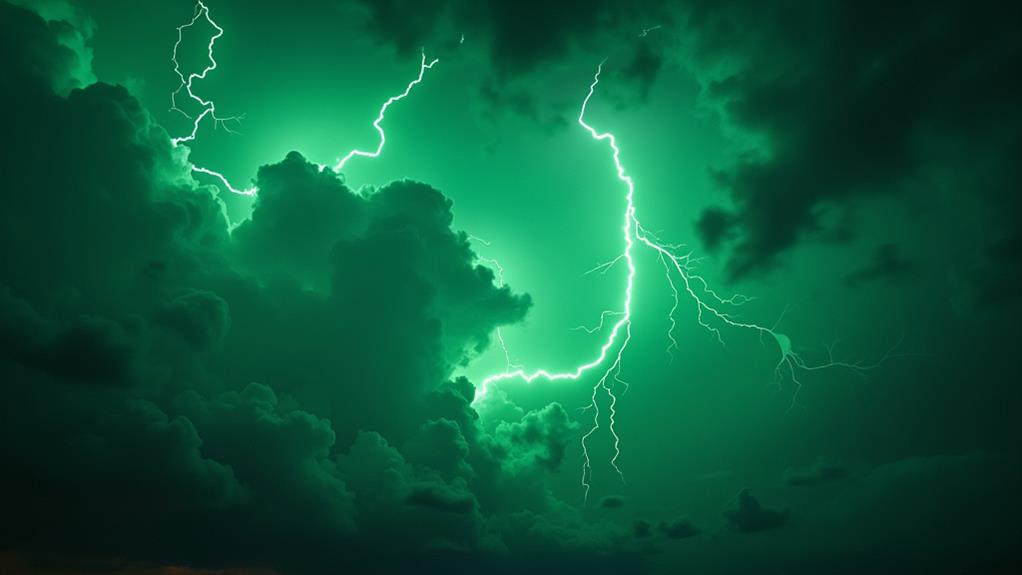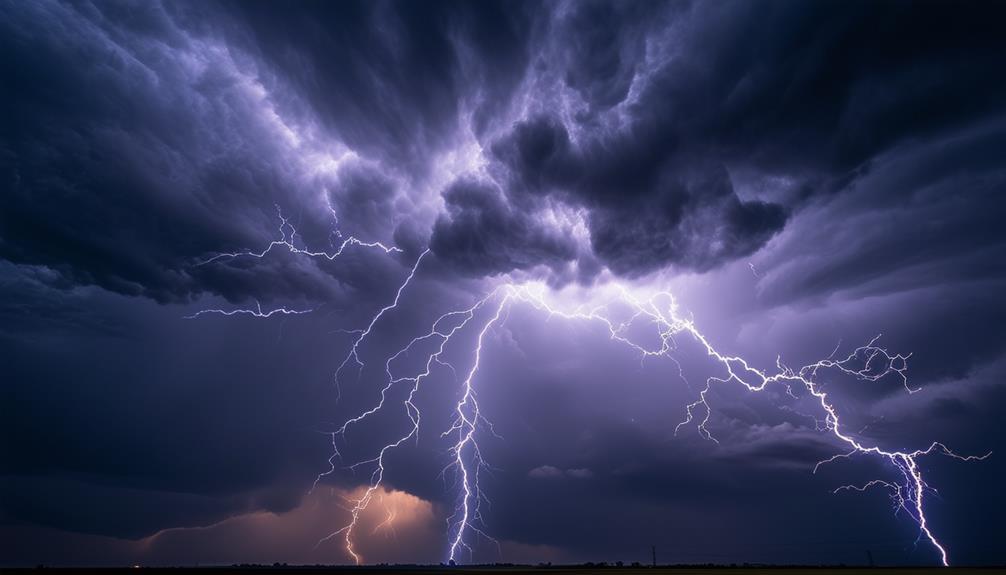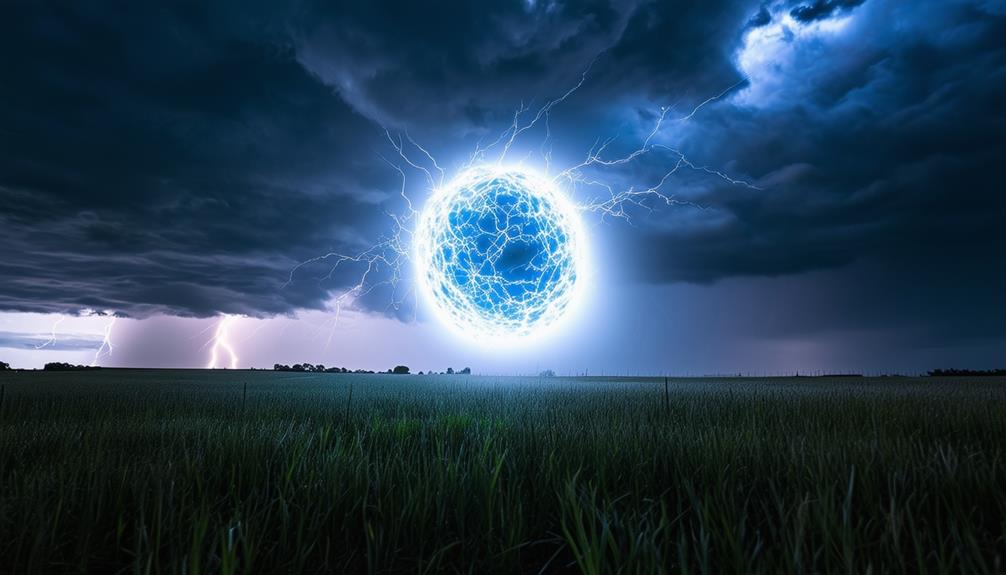How Volcanic Eruptions Trigger Green Lightning: The Explosive Connection
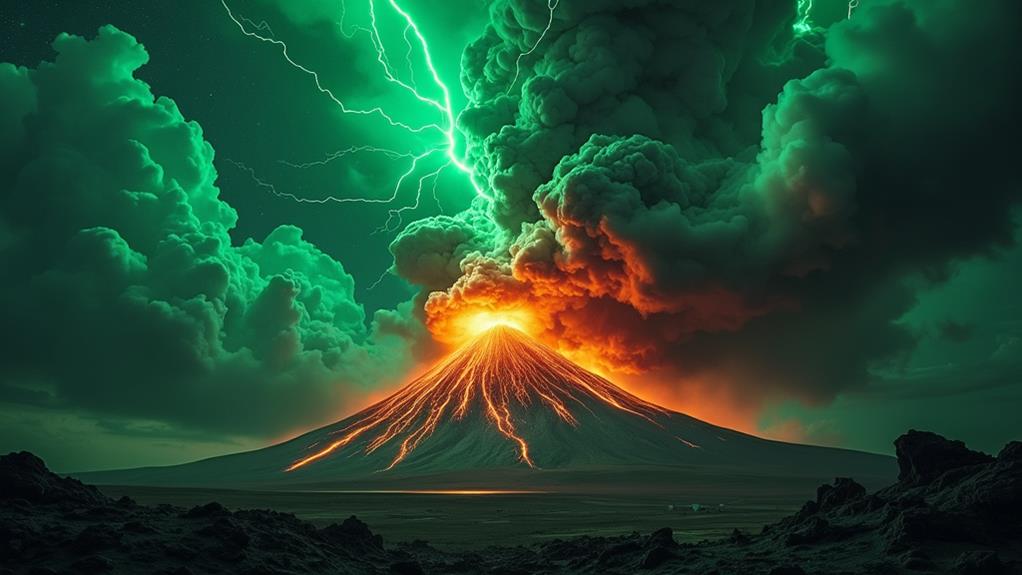
You might be intrigued by how volcanic eruptions can spark green lightning, an almost otherworldly phenomenon. The electrification of ash clouds through colliding particles generating frictional charges makes this process even more fascinating. First observed during the 2008 Chaiten eruption, the green hue arises from excited oxygen atoms. But what makes certain conditions—such as plume height, moisture content, and particle size—more conducive to this electrifying display? Understanding these factors not only enhances storm observation techniques but also illuminates the complex interactions between volcanic activity and the atmosphere.
The Phenomenon of Green Lightning
Green lightning is a captivating and rare phenomenon, first notably observed during the Chaiten volcano eruption in May 2008. Photographs captured against the nighttime sky revealed a green hue generated by electrically excited oxygen atoms in the atmosphere, similar to the aurora borealis. This type of lightning is particularly unique due to its association with volcanic eruptions, where interactions between charged volcanic ash clouds and positive streamers trigger electrical discharges.
Volcanic lightning occurs through plume electrification. During eruptions, volcanic ash becomes charged through frictional processes, setting the stage for electrical activity. These charged ash clouds interact with atmospheric conditions, producing the remarkable green lightning display.
Interestingly, green lightning isn't limited to volcanic activity. It is suspected to occur in all thunderstorms but is rarely seen, even by seasoned storm chasers, due to its concealment within storm clouds. This rarity enhances the mystery and allure of green lightning. Studying these events can improve storm observation techniques and potentially uncover new atmospheric phenomena, broadening our understanding of these electrifying occurrences.
Formation of Volcanic Lightning
During a volcanic eruption, ash plumes become electrically charged through collisions and fracturing of particles, similar to the processes in thunderstorms. Frictional charging from rock and ash particles, along with triboelectric effects, are crucial to this electrification. The presence of moisture in the plume enhances this effect, leading to more frequent and intense volcanic lightning.
Charge Generation Mechanisms
Ever wondered how volcanic eruptions produce spectacular lightning displays? It all begins with charge generation within the volcanic ash plume. When an eruption occurs, volcanic ash particles collide and fracture, creating electrical charges through frictional charging and triboelectric effects. These interactions are crucial for charge buildup.
Moisture in the ash plume significantly enhances electrification. Water vapor acts as a catalyst, facilitating the charging processes during the eruption. Furthermore, the size and composition of ash particles are important; larger particles and a mix of different sizes increase the efficiency of charge generation.
As the ash plume rises, positively charged rocks interact with negatively charged ash clouds, leading to rapid charge separation. This dynamic interaction triggers volcanic lightning by creating chaotic electrical activity. Tall ash plumes, often reaching altitudes of 7-12 kilometers, are particularly prone to increased lightning activity. The higher water vapor content at these altitudes amplifies the potential for electrification and lightning displays.
Understanding these charge generation mechanisms reveals the fascinating interplay between nature's forces, leading to the awe-inspiring phenomenon of volcanic lightning.
Ash Plume Electrification
Having explored the mechanisms behind charge generation in volcanic ash plumes, we now turn to the phenomenon of volcanic lightning. During an eruption, ash plume ejection leads to particle collisions and fracturing, generating electrical charges. This results in the accumulation of positive and negative charges, creating a highly electrified environment.
Frictional charging is crucial in this process. Collisions between rock fragments and ash particles facilitate electron transfer, intensifying charge separation within the plume. The presence of moisture further amplifies this effect, as water vapor enhances charge separation. Taller ash plumes, typically between 7-12 km high, are particularly prone to increased lightning activity due to higher water vapor content, which facilitates greater charge separation.
Silicate particles in the ash are significant contributors to this electrification process, playing a pivotal role in the electrical activity observed during eruptions. The outcome is a spectacular display of lightning bolts streaking through the ash plume. During intense explosive activity, these electrical discharges can occur at rates of up to 5000 per hour.
Charge Mechanisms in Ash Clouds
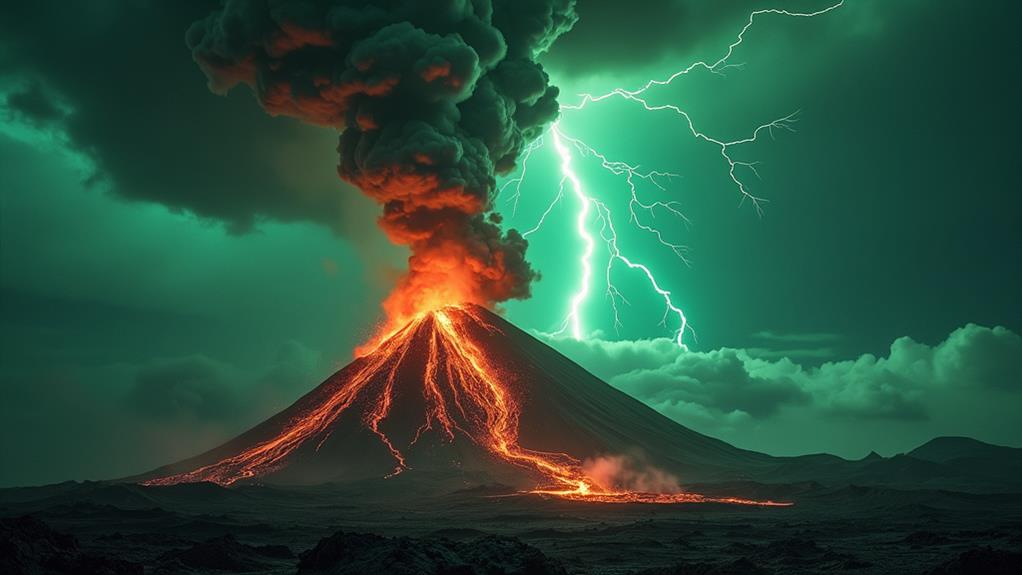
The electrification of volcanic ash clouds primarily results from particle collisions. As ash particles collide and fracture, frictional charging processes occur, leading to a buildup of electric charges within the plume. This electrification often results in the volcanic lightning observed during eruptions.
Particle Collision Effects
During volcanic eruptions, particle collisions within ash clouds are crucial for generating electrical charges. When ash particles collide and fracture within the turbulent environment of the eruption plume, they become electrically charged. These charged particles create an electric field, essential for lightning formation. The interactions between rock fragments and ash particles, combined with triboelectric effects, enhance the overall electrification of the ash cloud.
Key factors influencing this process include:
- Particle Size and Composition: Smaller ash particles have more surface area relative to their volume, making them more efficient at gaining and transferring electrical charges.
- Moisture Content: Water vapor within the ash plume increases the potential for electrification by facilitating charge separation.
- Plume Height: Taller ash plumes (7-12 km) experience increased lightning activity due to higher water vapor content at elevated altitudes.
- Collision Frequency: More frequent particle collisions lead to a greater buildup of electrical charges.
- Geological Impact: The interaction of volcanic ash with electrical discharges can result in the formation of volcanic spherules and "flash glass," highlighting the geological significance of these charge mechanisms.
Understanding these particle collision effects elucidates the intricate processes behind volcanic lightning.
Frictional Charging Processes
Building on our understanding of how particle collisions generate electrical charges, let's examine the frictional charging processes within volcanic ash clouds. During an eruption, ash and rock fragments collide and fracture, generating electrical charges. These particles can become positively or negatively charged depending on their size and composition. Larger, more abrasive particles are particularly effective at creating electrical charges through frictional charging.
Moisture in the ash plume plays a crucial role in enhancing electrification. It aids in charge separation, making lightning more likely during volcanic eruptions. The presence of moisture allows ash particles to become charged more easily, increasing overall electrical activity.
Ice particles also contribute to charge buildup. Similar to thunderstorm clouds, where ice nucleation and seeding processes occur, volcanic ash clouds can experience enhanced electrification due to these mechanisms. Ice particles help in separating charges, adding to the total electrical potential of the cloud.
The explosive nature of an eruption significantly impacts electrification efficiency. More vigorous eruptions generally result in higher rates of electrical activity. Understanding these frictional charging processes helps explain why volcanic eruptions can trigger spectacular lightning displays, including the rare phenomenon of green lightning.
Green Lightning Coloration
Green lightning, an awe-inspiring natural phenomenon, owes its distinctive hue to electrically excited oxygen atoms emitting light during volcanic eruptions. When particles collide within a volcanic plume, the intense friction generates electrical charges. These charges excite oxygen atoms, causing them to emit green light, similar to the way auroras illuminate the sky. This process creates the rare and striking green lightning.
Green lightning's rarity is partly due to its concealment within the dense structure of the volcanic plume. Unlike the frequent lightning in thunderstorms, green lightning is primarily observed during volcanic eruptions. The eruption of the Chaiten volcano in May 2008 is the only documented event where this phenomenon was photographed.
Key aspects of green lightning include:
- Electrically excited oxygen atoms: These produce light through the same process seen in auroras.
- Volcanic plume dynamics: The movement and collision of particles within the plume generate the necessary electrical charges.
- Visibility challenges: The cloud structure often conceals internal lightning, making sightings rare.
- Photographic rarity: Only one known photograph exists, highlighting its elusive nature.
- Volcanic specificity: This type of lightning is unique to volcanic activity, unlike more common thunderstorm lightning.
Understanding these factors enriches our appreciation of this extraordinary natural spectacle.
Historical Observations of Volcanic Lightning
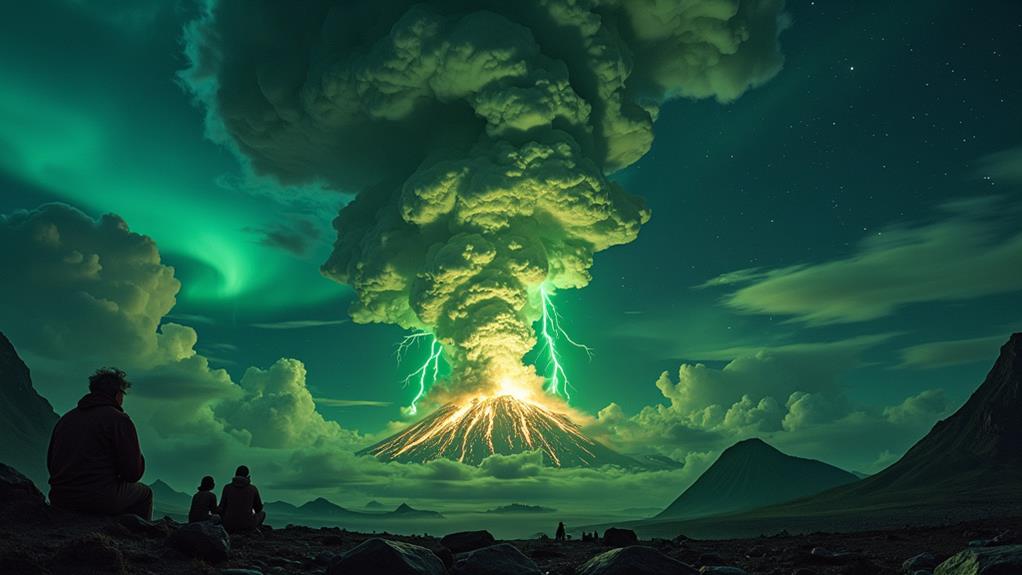
Throughout history, volcanic lightning has captivated and mystified observers, with some of the earliest documented accounts dating back to ancient times. One of the initial known descriptions comes from Pliny the Younger, who detailed the eruption of Mount Vesuvius in 79 AD. This awe-inspiring event highlighted the connection between explosive eruptions and lightning storms.
In the 19th century, Luigi Palmieri made the first scientific observation of volcanic lightning at Vesuvius, underscoring its significance in volcanic studies. Volcanic lightning, sometimes called a "dirty thunderstorm," continues to intrigue scientists and the public alike.
Significant events have been recorded globally, showcasing the widespread occurrence of this phenomenon. For instance, Mount Augustine in Alaska and Taal Volcano in the Philippines have both exhibited remarkable lightning activity during eruptions. The 2010 Eyjafjallajökull eruption in Iceland and the 2016 Sakurajima eruption in Japan further demonstrated the intense lightning storms associated with ash plumes.
Here's a table summarizing key volcanic lightning events:
| Year | Volcano | Location |
|---|---|---|
| 79 AD | Mount Vesuvius | Italy |
| 19th C | Vesuvius | Italy |
| 2006 | Mount Augustine | Alaska, USA |
| 2010 | Eyjafjallajökull | Iceland |
| 2021 | Tajogaite | La Palma, Spain |
Continuous monitoring, like during the 2021 Tajogaite eruption, provides valuable insights into the variations in electrical activity, enhancing our understanding of volcanic lightning dynamics.
Plume Characteristics and Lightning
Volcanic lightning is significantly influenced by the characteristics of the ash plume. Taller ash plumes, typically ranging from 7 to 12 kilometers in height, are more likely to generate increased lightning activity due to the higher water vapor content at these altitudes. The presence of moisture in volcanic ash plumes enhances the potential for charge generation, as it promotes the necessary collisions and interactions among ash particles for charge buildup.
The size and composition of ash particles are also critical factors in electrical activity. Larger particles facilitate more efficient electrification mechanisms. Variations in eruption styles and plume characteristics, such as temperature and height, lead to fluctuations in electrical discharge rates, with some eruptions exhibiting lightning rates of up to 5000 discharges per hour. The dynamic interactions between volcanic plumes and the atmosphere are key to determining the frequency and intensity of lightning strikes during eruptions.
Understanding these plume characteristics elucidates the unpredictable yet fascinating nature of volcanic lightning.
Impacts of Volcanic Lightning
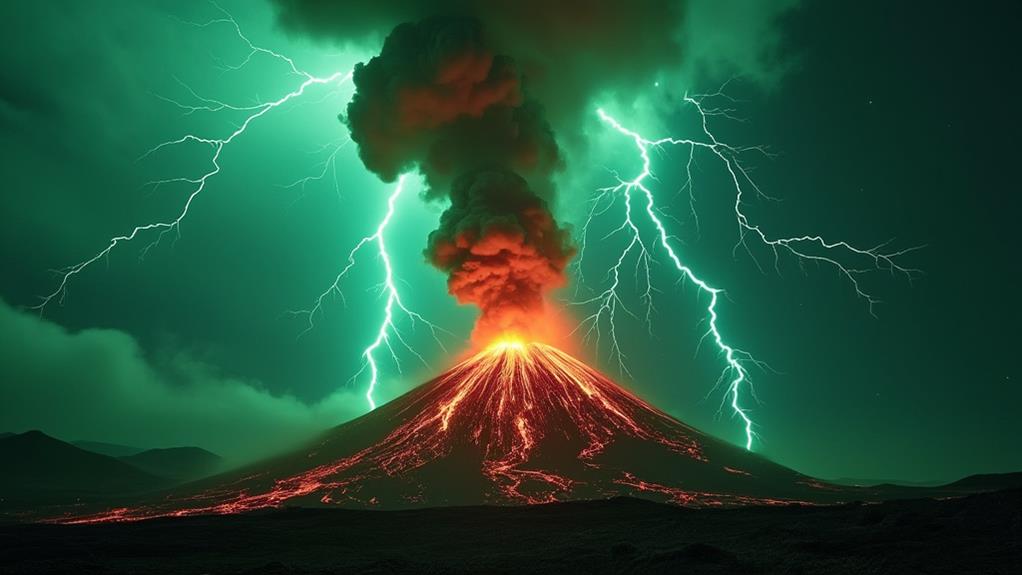
Volcanic lightning's impacts extend far beyond the visual spectacle, affecting diverse aspects of the environment and human activity. When you witness volcanic lightning, you're not just seeing an electrifying show; you're observing a powerful force that shapes geological formations. The interaction between electrical discharges and ash particles can produce volcanic spherules, creating unique glassy materials known as "flash glass."
In aviation, volcanic lightning poses significant hazards. Large ash clouds generated during eruptions can disrupt flight paths and damage aircraft, making it a critical safety concern. Pilots and airlines must remain vigilant to avoid these perilous conditions.
On the ground, the electrical discharges from volcanic lightning can ignite fires in vegetation and structures, leading to environmental and economic losses. These fires add another layer of destruction to already catastrophic volcanic events.
Volcanic lightning also contributes to atmospheric changes. The interaction between lightning and ash particles can alter atmospheric chemistry, influencing climate and weather patterns. This underscores the broader environmental impacts that extend well beyond the immediate eruption.
Research and Monitoring Techniques
Research and monitoring techniques are essential for understanding the complex dynamics of volcanic eruptions and phenomena such as green lightning. Utilizing advanced monitoring technologies enables the tracking of variations in electrical activity during eruptions, providing insights into the underlying processes.
For example, electrostatic lightning detectors played a crucial role during the 2021 Tajogaite eruption in La Palma, revealing that silicate particle charging was the primary mechanism for electrification, with discharge rates reaching up to 5000 discharges per hour.
To deepen your understanding, consider the following techniques:
- Thermal videography: Correlates temperature variations with electrical activity.
- Seismic measurements: Offer insights into tremor amplitudes associated with eruption intensity.
- Plume height observations: Allow observation of the relationship between plume dynamics and electrical discharges.
- Principal Component Analysis (PCA): Analyzes tremor amplitudes, linking changes in electrical signatures to eruption intensity.
- Continuous data collection: Facilitates real-time correlation between electrical activity and eruption dynamics.
These methods are vital for identifying the mechanisms behind charge generation and green lightning. By refining detection techniques and enhancing understanding, you can better predict and analyze electrical phenomena during volcanic eruptions, contributing to improved safety and scientific knowledge.
Future Directions in Study
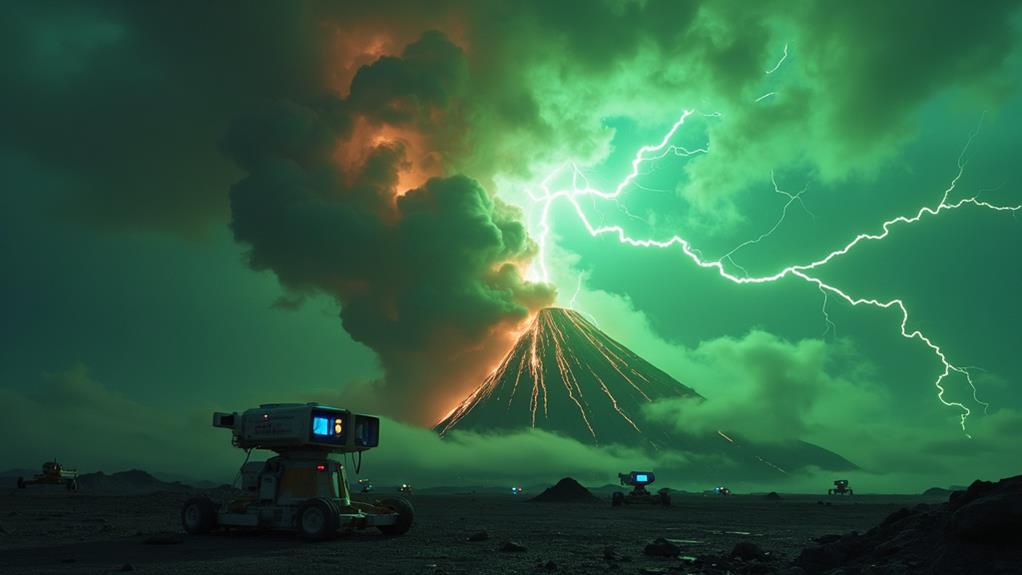
Future research on green lightning during volcanic eruptions will aim to uncover the specific cloud conditions and electrical charge mechanisms that make it visible. Researchers will delve into the relationships between plume height, ash particle size, and the frequency of green lightning events. Taller ash plumes, which have been noted to increase electrical activity, are of particular interest.
Advanced monitoring technologies, such as electrostatic lightning detectors, will be crucial in these investigations. These tools can provide real-time data on charge generation within volcanic ash clouds, offering insights into the distribution of positively and negatively charged particles. This data not only aids in understanding green lightning but also enhances eruption forecasting, potentially saving lives.
Collaboration is essential. Volcanologists and atmospheric scientists must work together to explore how green lightning impacts climate change and atmospheric chemistry. By examining historical eruption data, such as from the Chaitén volcano, patterns may emerge that improve our understanding of green lightning's prevalence in various volcanic settings.
In essence, future research will be a multidisciplinary effort, leveraging advanced technology and historical data to unravel the mysteries of green lightning and its broader environmental implications.

